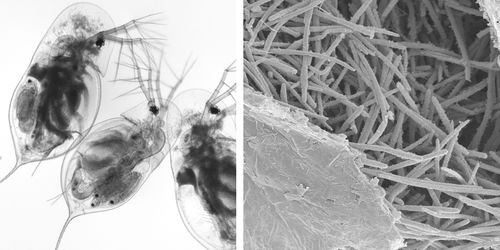Metschnikowia bicuspidata: Difference between revisions
| Line 41: | Line 41: | ||
[[File:Infected Daphnia healthy Daphnia and TEM Metschnikowia spores.jpeg| | [[File:Infected Daphnia healthy Daphnia and TEM Metschnikowia spores.jpeg|500px|thumb|left|From left, an infected Daphnia, an uninfected Daphnia, and an infected Daphnia. On right, an electron microscopy image showing spores as they appear under the ruptured carapace of a Daphnia. (Hall et al.)]] | ||
==References== | ==References== | ||
Revision as of 19:53, 26 April 2015
Introduction
Metschnikowia is a genus in the Kingdom Fungi (Naumov, 2011). Metschnikowia species are single-celled (i.e., yeast) parasites of the freshwater zooplankton genus Daphnia (ibid.).
Description and Significance
___only one morphological form has been observed.
The organism exists as single-celled needle-shaped spores (Naumov, 2011). __dimensions Metschnikowia lives in freshwater lakes ___where? It survives by ___ It is a pathogen of Daphnia; a spore uses the host's body as a reproduction factory. After puncturing the gut wall, it uses energy from the host? to produce thousands of identical spores. These increase in number until the Daphnia body bursts; a single Daphnia carcass can contain up to ___ spores, with typical numbers near ___.
__second host?
Classification
Eukaryota, Fungi, Dikarya, Ascomycota, Saccharomycotina, Saccharomycetes, Saccharomycetales, Metschnikowiaceae, Metschnikowia (European Nucleotide Archive, accessed 21 April 2015)
Species
There are three varieties in the species: M. bicuspidata var. bicuspidata, var. californica, and var. chathamia (Naumov, 2011).
Genome Structure
Describe the size and content of the genome. How many chromosomes? Circular or linear? Other interesting features? What is known about its sequence?
Cell Structure, Metabolism and Life Cycle
Interesting features of cell structure; how it gains energy; what important molecules it produces.
Ecology and Pathogenesis
Habitat; symbiosis; biogeochemical significance; contributions to environment.
If relevant, how does this organism cause disease? Human, animal, plant hosts? Virulence factors, as well as patient symptoms.
habitat symbionts biogeochemical significance contributions to environment how cause disease?
References
http://www.ebi.ac.uk/ena/data/view/Taxon:Metschnikowia%20bicuspidata%20var.%20bicuspidata%20NRRL%20YB-4993 European Nucleotide Archive. Metschnikowia bicuspidata var. bicuspidata NRRL YB-4993. accessed 21 April 2015.
Naumov, G. I. "Molecular and genetic differentiation of small-spored species of the yeast genus Metschnikowia Kamienski." Microbiology. 2011. Volume 80(2). pp. 135-142.
Author
Page authored by Katie Griebel and Jacob Gelarden, students of Prof. Jay Lennon at Indiana University.

